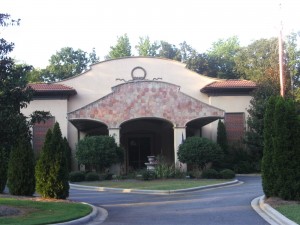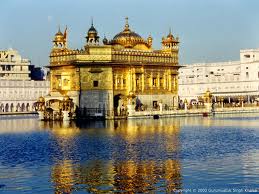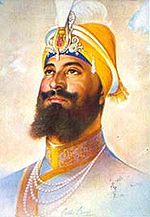I’ve heard it translated a few ways: “House of the Guru,” “House of God”…either way, this is the base of communal and spiritual life for all Sikhs. Just about anywhere in the world you find a Sikh, rest assured there is a gurdwara nearby and they come in all shapes and sizes.

And here is the Harimandir, or, The Golden Temple surrounded by the Amrit Sarowar (Tank of Nectar) in Amristar, Punjab.

Central to each gurdwara is the darbar, the sanctuary where the Guru Granth Sahib resides and is read from during the day. Upon entering the presence of the Guru Granth Sahib, Sikhs fold their hands, prostrate before the Guru, and usually contribute some sort of offering (usually a monetary donation). After one pays their respects to the Guru, man or woman takes their seat on the floor–usually separated on either side of the room and with their heads covered.

Local Sikhs gather as a Sangat (congregation) to sing kirtan along with music, that is, hymns from the Guru Granth Sahib itself. Afterward, the Sangat listens to a reading and discourse of the Guru Granth Sahib, followed by Ardas or prayer/supplication to God for blessings upon the community and mankind. The Ardas contains language which reminds the Sikh about the struggles and sacrifices made by those of the past who ensured the freedom of religion they enjoy today. In closing, the Sangat partakes in prasad, a combination of wheat flour, ghee and sugar, is shared by the congregation.
Another important feature of the gurdwara is the langar, or communal kitchen. The langar is available to anyone, regardless of caste, religion, race, creed, or any other identifying features. Originally set up by Guru Nanak, the first Guru of the faith, the langar is shared by all on equal standing. King or peasant, all sit on the floor and eat side-by-side. It is considered a great honor and act of piety to serve the langar or even dust the shoes of visitors. Guru Amar Das required everyone who sought his teaching to first eat at the langar for a quick and effective lesson in equality. Many gurdwaras are also known to house weary travelers and give them rest before returning on their journeys.
Gurdwaras also bear a Nishan Sahib, a triangular, yellow flag at the end of a tall pole with the Sikh symbol, the Khanda.
Another feature of the gurdwara is the granthi, who serves more as a custodian of the Guru Granth Sahib within the gurdwara, as there is no priestly class within the Sikh faith. The granthi performs the morning and evening ceremonies of Parkash (opening of the Guru Granth Sahib in the morning) and Sukh Asan (closing of the Guru Granth Sahib in the evening), as well as attending to visitors, reading from the Guru Granth Sahib during services, performing prayers, and other functions.
In a way, I am my own diaspora this month, as my gurdwara is 2 1/2 hours away. I visited my Mentor there late last month where he offered the “Five K’s” as gifts for me to use this month and introduced me to the faith. Though I am attending service on September 11th with the Charlotte sangat, I am still alone day-to-day. It’s odd here, being the only person in town wearing a dastar (turban) with no one to share the stares with. Guru Gobind Singh said of the Khalsa that they would stand out as one among millions because of the uniform (Five K’s) of the Amritdari, one who has taken the Amrit baptism. I truly feel that way. Every time I look down at the heavy kara on my wrist, or feel the kirpan by my side, I’m reminded of whom I represent so far away.
It is said that a gurdwara is where the Guru Granth Sahib resides. My only copy is an electronic one I read from on the computer, however my Mentor did give me a written copy of the Japji Sahib, the opening hymns of the Granth Sahib. This text is situated in my living room upon the “alter-shelf” and I bow to it every time I enter the room. I suppose then that there is a gurdwara here in this one-Sikh town of mine after all; right in my living room. But the sangat exists with the Congregation as well, who supports my efforts daily. Sometimes it’s tough for folks to understand that the gathering on the Facebook page is sometimes the only thing that pulls me through each day. A faith community–even a virtual one–is so important. Never take your spiritual family for granted.


